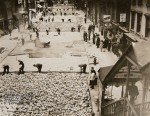 Last month, New York City’s Department of Records announced that it had digitized and uploaded 870,000 of the best photographs out of the 2,200,000 kept in the city’s Municipal Archives. The pictures date from the mid-1800s onward and document every aspect of city governance, from bridges to iconic buildings to mug shots to crime scenes to road work that captures vibrant immigrant neighborhoods as they were before gentrification flattened their characters. A few of them have been published before, but most of them are revelations.
Last month, New York City’s Department of Records announced that it had digitized and uploaded 870,000 of the best photographs out of the 2,200,000 kept in the city’s Municipal Archives. The pictures date from the mid-1800s onward and document every aspect of city governance, from bridges to iconic buildings to mug shots to crime scenes to road work that captures vibrant immigrant neighborhoods as they were before gentrification flattened their characters. A few of them have been published before, but most of them are revelations.
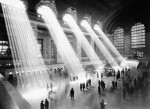 The Department of Records has been working for four years to make this vast store of hidden gems available to the public as part of an initiative to make city records generally accessible. Until now, if you wanted to see any of these pictures, you had to go to the archive building and go through the microfilm and print records. Although the entire archive hasn’t been uploaded at this point because it’s on a tight technological and funding budget, the department will continue to add new content to the online database.
The Department of Records has been working for four years to make this vast store of hidden gems available to the public as part of an initiative to make city records generally accessible. Until now, if you wanted to see any of these pictures, you had to go to the archive building and go through the microfilm and print records. Although the entire archive hasn’t been uploaded at this point because it’s on a tight technological and funding budget, the department will continue to add new content to the online database.
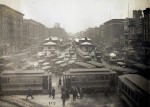 Those technological limitations became immediately obvious when the day after the database opened, it crashed. The interest was massive and came from all over the world, which meant that the poor server never caught a break.
Those technological limitations became immediately obvious when the day after the database opened, it crashed. The interest was massive and came from all over the world, which meant that the poor server never caught a break.
“There is so much world-wide interest,” said Eileen Flannelly, deputy commissioner for the city’s Department of Records. “We knew it would be huge in the city and for New Yorkers, but the actual interest coming in from Germany and Spain and Brazil and the Czech Republic, all of these places, they can’t get enough of it. Like 12,000 hits every few minutes in the middle of the night.”
It was down for weeks before they finally got their act together. Now the site is stable and therefore finally bloggable.
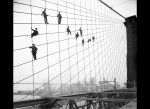 Most of the pictures were taken by anonymous municipal workers in the course of their duties, although there are some standout pieces by professionals like Eugene de Salignac, the Boston-born descendant of French nobility who at the age of 42 became the official photographer for the Department of Bridges/Plant and Structures in 1906. The department’s only photographer, over the next three decades he took 20,000 pictures of Manhattan’s most famous landmarks as they went up. He retired in 1934 and died in 1943, a virtual unknown, until in 1999 Municipal Archives photographer Michael Lorenzini recognized that a number of outstanding photographs had to be the work of one man. Lorenzini dug through the archives and historical records and finally put a name to the prodigious talent, bringing de Salignac out of obscurity into museum exhibits and coffee table books.
Most of the pictures were taken by anonymous municipal workers in the course of their duties, although there are some standout pieces by professionals like Eugene de Salignac, the Boston-born descendant of French nobility who at the age of 42 became the official photographer for the Department of Bridges/Plant and Structures in 1906. The department’s only photographer, over the next three decades he took 20,000 pictures of Manhattan’s most famous landmarks as they went up. He retired in 1934 and died in 1943, a virtual unknown, until in 1999 Municipal Archives photographer Michael Lorenzini recognized that a number of outstanding photographs had to be the work of one man. Lorenzini dug through the archives and historical records and finally put a name to the prodigious talent, bringing de Salignac out of obscurity into museum exhibits and coffee table books.
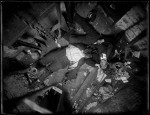 The database also includes a grimly fascinating collection of glass-plate photographs taken by the New York City Police Department. It’s the largest collection of criminal justice evidence in the English-speaking world, and it’s amazing how many of these grisly murder scenes are so artful they could easily be stills from a film noir.
The database also includes a grimly fascinating collection of glass-plate photographs taken by the New York City Police Department. It’s the largest collection of criminal justice evidence in the English-speaking world, and it’s amazing how many of these grisly murder scenes are so artful they could easily be stills from a film noir.
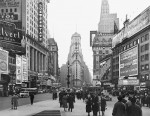 Less bloody but just as fascinating are the 1,279 images collected by the Works Progress Administration’s Federal Writers’ Project, a New Deal program that between 1935 and 1943 collected pictures from Art Project photographers and others for inclusion in publications like the WPA Guide to New York City. When the program ended, the Municipal Archives acquired the collection.
Less bloody but just as fascinating are the 1,279 images collected by the Works Progress Administration’s Federal Writers’ Project, a New Deal program that between 1935 and 1943 collected pictures from Art Project photographers and others for inclusion in publications like the WPA Guide to New York City. When the program ended, the Municipal Archives acquired the collection.
You can search the database by keyword or department, or you can browse by categories. I prefer the categories because I like going through the pictures from oldest to newest.
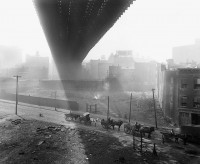
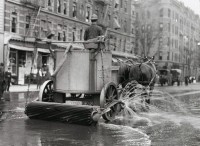
It irks me that they don’t use some sort of a Creative Commons licensing schema in this day and age. I don’t want to buy prints, but I would like to use the reasonably high-res (not the ca 50MB digital files that you can order) for anything that I desire. Is this due to the different levels of freedom of municipalities in the federal government? Because I know for sure that the images created by Whitehouse, the US Army, the Parks Department, etc are free of these limitations (if you can find a file online that has good enough quality).
I think it’s purely a pecuniary choice. They want to recoup their expenditures by selling prints and digital files. I understand the former — the LoC etc. also sell prints to make some money — but I agree with you that it’s petty to try to scrounge a buck off the digital files when sharing them far and wide online will only send them more paying customers for the prints.
Sorry, I beg to differ. I have worked for hundreds of hours as a volunteer digitizing natural history specimens at a comparably large institution–for the benefit of the general public–and copyright free for non-commercial use to boot. Even with tons of “free” labor–these institutions incurr enormous expenses to bring this material to the public. Otherwise, there would be much less to look at out there on the Internet. It seems to me that the “if it’s on the Internet, it ought to be free” line of thinking is shortsighted. If only in consideration for the taxpayers of NYC, we ought assume that it’s the right thing to do by contributing something.
I don’t think something should be free just because it’s on the Internet, but I do think they should have quality digital images available to the public without requiring payment. For one thing, a digital file has no overhead. You can send it to a million people without incurring any costs, unlike prints which have material expenditures (paper, development, printing).
That doesn’t mean that is has to be a free-for-all. They could, for instance, offer high resolution images if you use their rather nice JavaScript embedding system that allows people to zoom in and explore pictures in detail. As it stands, those Java embeds are too dinky to be of much use.
I well remember the crashing of this site at the time it was launched. And I remember saying to myself, “Self, if only all those liberal-progressives didn’t click over here from the New York Times site and the MSNBC Photoblog showcasing that shot of the painters on the cables of the Brooklyn Bridge, we troglodyte conservatives would have a shot at downloading pictures of an older and wiser America for our desktop wallpaper.”
Is that what you call a ‘crashed site’ ? – When I first read the headline, it reminded me of the physical(!) collapse of the municipal archive in cologne back in 2009, https://en.wikipedia.org/wiki/Historical_Archive_of_the_City_of_Cologne#Collapse_of_the_archive_in_2009 – Back to marble ftw.
:hattip:
Even marble buildings crash when a subway gets dug underneath them. Poor Cologne… :no:
Oh man so much awesome. You could make a fantastic gallery wall
Wow, what a wonderful treasure. I’m going to look at all the crimes!
There are some incredible crime scene photos, including ones by Weegee, the master of the genre.
true, buildings crash, but what I was trying to suggest here were things like ‘blog entries’, documents etc. in marble. :hattip:
It is true that the costs are very big indeed (I work in a memory institution that is grappling with the same problems). At the same time I think that most of their money should come from selling hyper-high resolution digital files, prints and all sorts of other memorabilia. Making the regularly large sized files (like the ones linked to from this article) free to use when the user attributes the institution seems to me like a real winner. These images are meant to be used, spread and rethought. There might be some limitations in regards to using them in advertising, but (almost) everything else should be free game.
I agree. The more people know about it, the more paying customers you have. Companies pay for publicity all the time. The Municipal Archives would be getting it for free.
This blog is quite interesting. Just finished reading comments and now starting to read your main blog.
I don’t think I can emphasize enough how much I’ve enjoyed this resource so far. I did go look at all the crimes and curious about certain pictures, looked up the New York Times articles. I’ve learned so much about crime in old timey New York, including the unsolved “Ripper” crimes that targeted children. A horrible image of a disemboweled child, in haunting clarity, lead me to it. Just an outstanding thing, thank you for posting again.
Ah, the Charles Murray murder. That’s an image that stays with you. Were you able to find out if anyone was ever convicted of being the East Side Ripper? After the NYT article, I hit a brick wall right away.
As far as I’ve been able to track, the case remained unsolved.
Wow, what a wonderful treasure. I’m going to look at all the crimes!